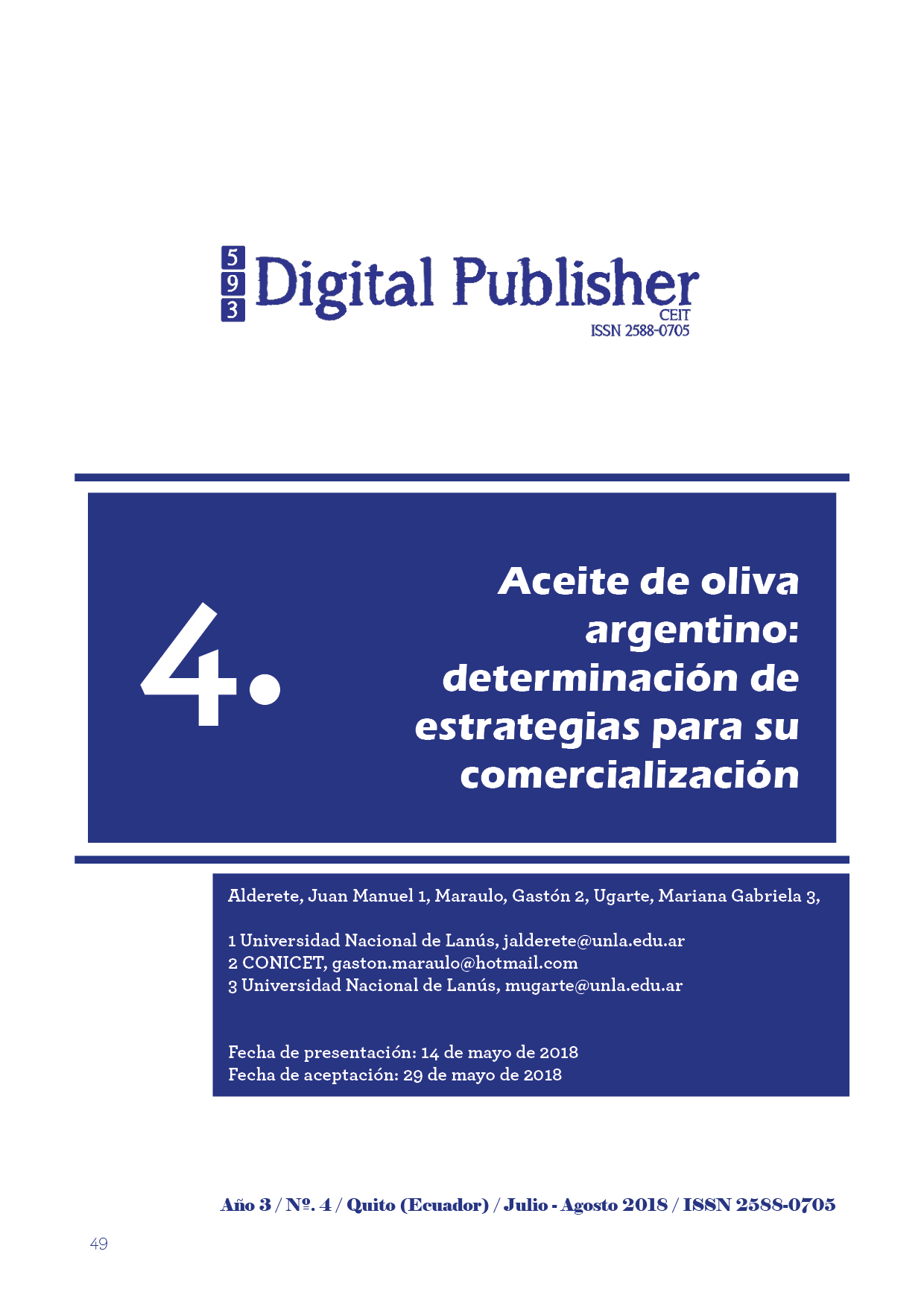Aceite de oliva argentino: determinación de estrategias para su comercialización
Main Article Content
Abstract
The objective of this work is to determine the optimal marketing strategies for the main destinations of argentine olive oil, inasmuch as the largest proportion of it is exported as a pure commodity. Thus, the product turns to the market without the possibility of influencing the formation of prices and defining its competitiveness based on the optimization of costs. However, an analysis of the main export destinations separately configures the opportunity to diversify the competitive strategies, in order to adapt the marketing to each particular case.
For this, it was necessary to determine the most important destinations for Argentine olive oil, so we proceeded to average the exports of olive oil for each market placement in the last five years registerend by the Estatisitcs and Censuses National Institute (2011-2014). The United States of America, Brazil, Spain, Chile and Uruguay were revealed as the most important destinations in decreasing order. In order to determine the most appropriate commercial strategy for each case, the Agroalimentary Consumption Analysis Model (MACA) was applied for the last decade available in FAO data bases (2002-2011). Thus, the annual consumption of the product was taken during the referred decade and the average variation of consumption was obtained as the slope associated to a linear regression on the series. We proceeded in the same way with the consumption of the entire basket of products that compete with each other, including that of our interest.
In this way, an ordered pair of data was obtained for each market (variation of the entire class to which the product belongs -VC- and variation of the product -VP). In the case in question, real consumption was estimated through the domestic supply of each country (the sum of imports, production and change in stocks minus exports) expressed in kg / inhabitant / year. Depending on the ordered pair obtained for a destination, there will be a different strategy to address it: positive VC and positive VP define a sustainable or growing market, approachable through a cost reduction strategy; Positive VC and negative VP define a vulnerable or tired market, approachable through a differentiation strategy; Negative VC and Positive VP define a strong or vigorous market, approachable by optimizing logistics and distribution; finally, negative VC and negative VP define a receding or falling market, approachable through a combination of the above strategies in a broader policy framework.
In this way, the United States, Uruguay, Spain and Brazil were shown as sustainable markets, while Chile appears as a shrinking market, being determined the relevant commercial strategies according to the exposed criterion, and confirming that for a single product, the different Markets require specific strategies.
Downloads
Article Details
1. Derechos de autor
Las obras que se publican en 593 Digital Publisher CEIT están sujetas a los siguientes términos:
1.1. 593 Digital Publisher CEIT, conserva los derechos patrimoniales (copyright) de las obras publicadas, favorece y permite la reutilización de las mismas bajo la licencia Licencia Creative Commons 4.0 de Reconocimiento-NoComercial-CompartirIgual 4.0, por lo cual se pueden copiar, usar, difundir, transmitir y exponer públicamente, siempre que:
1.1.a. Se cite la autoría y fuente original de su publicación (revista, editorial, URL).
1.1.b. No se usen para fines comerciales u onerosos.
1.1.c. Se mencione la existencia y especificaciones de esta licencia de uso.
References
Alderete, J. M., Aulicino, J. M. & Ugarte, M. G. (2017). Bases para la diferenciación de alimentos: un avance hacia el agregado de valor. Lanús: EdUnla.
Chaddad, F., Senesi, S., Vilella, F. & Palau, H. (2009). The emergence of hybrid forms in Argentina’s grain production sector. 19th International Food & Agribusiness Management Association (IAMA). Budapest, Hungary.
Giacinti, M. Á. (2001). Consumo mundial de frutas, hortalizas, miel y bebidas alcohólicas. Tendencia mundial en la década de los noventa. Agroalimentaria, 7(12).
Giacinti, M. Á. (2003). Pensamiento estratégico en el negocio mundial de manzanas. Agroalimentaria, 8(17), 49-60.
González, A. (2017). La diferenciación de commodities más allá del precio y el servicio. Paper presented at the II Congreso Internacional Virtual sobre Desafíos de las Empresas del Siglo XXI.
Ordoñez, H. A. (2009). La nueva economía y negocios agroalimentarios: Facultad de Agronomía de la Universidad de Buenos Aires-FAUBA.
Porter, M. E. (2011). Competitive advantage of nations: creating and sustaining superior performance (Vol. 2): Simon and Schuster.

